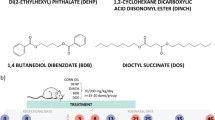Abstract
Aroclor 1254 was fed to female and male rats daily for 9 weeks at a dose of 6.4 mg/kg in their drinking water. Control animals received plain tap water plus the emulsifier (0.15% Tween 80). Elevated mixed function oxidase (MFO) activity appeared to be due to 2,4,5,2′,4′,5′- and 2,4,5,2′3′4′-hexachlorobiphenyls, since only these compounds were present to any degree in the tissues of the animals when MFO activity persisted after termination of exposure. The placenta apparently is an effective barrier to PCB transfer.
Similar content being viewed by others
References
Albro, P. W., and L. Fishbein: Intestinal absorption of polychlorinated biphenyls in rats. Bull. Environ. Contam. Toxicol.2, 26 (1972).
Bailey, S., and P. J. Bunyan: Interpretation of persistence and effects of polychlorinated biphenyls in birds. Nature236, 34 (1972).
Bennett, G. A., C. K. Drinker, and M. F. Warren: Morphological changes in the livers of rats resulting from exposure to certain chlorinated hydrocarbons. J. Indust. Hyg. Toxicol.20, 97 (1938).
Bush, B., and Fa-Chun Lo: Thin layer chromatography for quantitative polychlorinated biphenyl analysis. J. Chromatog.77, 377 (1973).
Bush, B., C. F. Tumasonis, and F. D. Baker: Toxicity and persistence of PCB homologs and isomers in the avian system. Arch. Environ. Contam. Toxicol.2, 195 (1974).
Chen, P. R., H. M. Mehendale, and L. Fishbein: Effect of two isomeric tetrachlorobiphenyls on rats and their hepatic enzymes. Arch. Environ. Contam. Toxicol.1, 36 (1973).
Curley, A., V. W. Burse, and M. E. Grim: Polyclorinated biphenyls: Evidence of transplacental passage in the Sherman rat. Fd. Cosmet. Toxicol.11, 471 (1973).
Daly, J. W., D. M. Jerina, and B. Witkop: Arene oxides and the NIH shift: The metabolism, toxicity, and carcinogenicity of aromatic compounds. Experientia28, 1129 (1972).
Drinker, C. K., M. F. Warren, and C. A. Bennett: The problems of possible systemic effects from certain chlorinated hydrocarbons. J. Ind. Hyg. Toxicol.19, 283 (1937).
FDA: Federal Register37, 5705 (1972).
Friend, M., and D. O. Trainer: Polychlorinated biphenyl: Interaction with duck hepatitis virus. Science170, 1314 (1970).
Gardner, A. M., J. T. Chen, J. A. G. Roach, and E. P. Ragelis: Polychlorinated biphenyls: Hydroxylated urinary metabolites of 2,5,2′,5′-tetrachlorobiphenyl identified in rabbits. Biochem. Biophys. Res. Comm.55, 1377 (1973).
Hutzinger, O., D. M. Nash, S. Safe, A. J. W. DeFreitas, R. J. Norstrom, D. J. Wildish, and V. Zitko: Polychlorinated biphenyls: Metabolic behavior of pure isomers in pigeons, rats, and brook trout. Science178, 312 (1972).
Jensen, E. V., M. Numater, P. T. Breecher, and E. R. DeSombre: Biochemistry Society Symposium No. 32, R. M. S. Smellie, Ed., pg. 133. Academic Press, New York (1971).
Kato, R., and J. R. Gillette: Six differences in the effects of abnormal physiological states on the metabolism of drugs by rat liver microsomes. J. Pharmac. Exp. Ther.150, 285 (1965).
Kato, T., M. Yakushiji, H. Tuda, A. Arima, K. Takahashi, M. Shimomura, M. Miyahara, M. Adachi, Y. Tashiro, and M. Matsumoto: Polychlorinated (PCB) induced fetopathy. II. Experimental studies: Possible placental transfer of polychlorobiphenyls in rats. Kurume Med. J.19, 53 (1972).
Litterst, C. L., and E. P. Lichenstein: Effects and interactions of environmental chemicals on human cells in tissue culture. Arch. Environ. Health22, 454 (1971).
Miller, J. W.: Pathologic changes in animals exposed to a commercial chlorinated diphenyl. Public Health Rpts.59, 1085 (1944).
Norback, D. H., and J. R. Allen: Enzymatic and morphologic alterations in hepatic endoplasmic reticulum induced by a chlorinated aromatic hydrocarbon. Fed. Proc.29, 816 (1970).
Omura, T., and R. Sato: The carbon monoxide-binding pigment of liver microsomes. I. Evidence for its hemoprotein nature. J. Biol. Chem.239, 2370 (1964).
Orberg, J., and C. Lundberg: Metabolism of two pure isomers of PCB (Abstract). The Third International Congress of Pesticide Chemistry, Helsinki, Finland (1974).
Platonow, N., and N. Y. Chen: Transplacental transfer of polychlorinated biphenyls (Aroclor 1254) in a cow. Vet. Record (Jan. 20, 1973).
Richterich, R.: Clinical Chemistry Theory and Practice, pg. 245. Academic Press, New York (1969).
Török, P.: Effect of 2,2′-dichlorobiphenyl of embryonal development of the NMRI mouse (Abstract). The Third International Congress of Pesticide Chemistry, Helsinki, Finland (1974).
Tumasonis, C. F., B. Bush, and F. D. Baker: PCB levels in egg yolks associated with embryonic mortality and deformity of hatched chicks. Arch. Environ. Contamin. Toxicol.1, 312 (1973).
Villeneuve, D. C., D. L. Grant, K. Khera, D. L. Clegg, H. Baer, and W. E. J. Phillips: The fetotoxicity of a polychlorinated biphenyl mixture (Aroclor® 1254) in the rabbit and the rat. Environ. Physiol.1, 67 (1971).
Vos, J. G., J. J. T. W. A. Stick, C. W. M. Van Holsteyn, and J. H. Pennings: Polychlorinated biphenyls as inducers of hepatic porphyria in Japanese quail with special reference to 5-aminolevulinic acid synthetase activity, fluorescence and residues in the liver. Toxicol. Appl. Pharmacol.20, 232 (1971).
Yamamoto, H., and H. Yoshimura: Metabolic studies on polychlorinated biphenyls. III. Complete structure and acute toxicity of the metabolites of 2,4,3′,4-tetrachlorobiphenyl. Chem. Pharm. Bull.21, 2237 (1973).
Yoshimura, H., H. Yamamoto, and S. Saeki: Metabolic studies on polychlorinated biphenyls. II. Metabolic fate of 2,4,3′,4′-tetrachlorobiphenyl in rats. Chem. Pharm. Bull.21, 2231 (1973).
Author information
Authors and Affiliations
Additional information
We also appreciate the advice, help, and facilities furnished by Dr. Melvin K. Abelseth, Director, Laboratories for Veterinary Science, New York State Department of Health.
Rights and permissions
About this article
Cite this article
Baker, F.D., Bush, B., Tumasonis, C.F. et al. Toxicity and persistence of low-level PCB in adult wistar rats, fetuses, and young. Arch. Environ. Contam. Toxicol. 5, 143–156 (1977). https://doi.org/10.1007/BF02220897
Received:
Accepted:
Issue Date:
DOI: https://doi.org/10.1007/BF02220897




